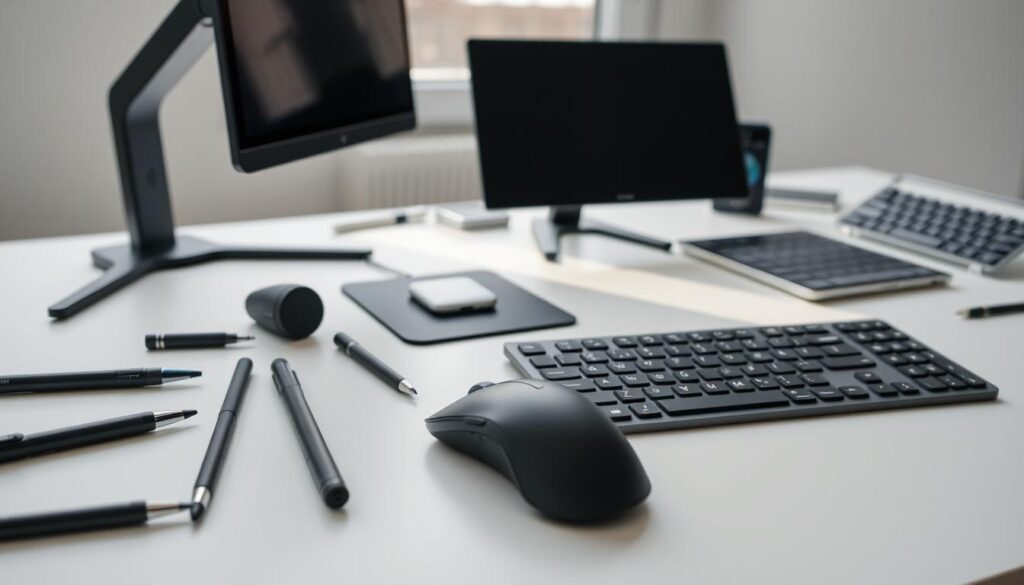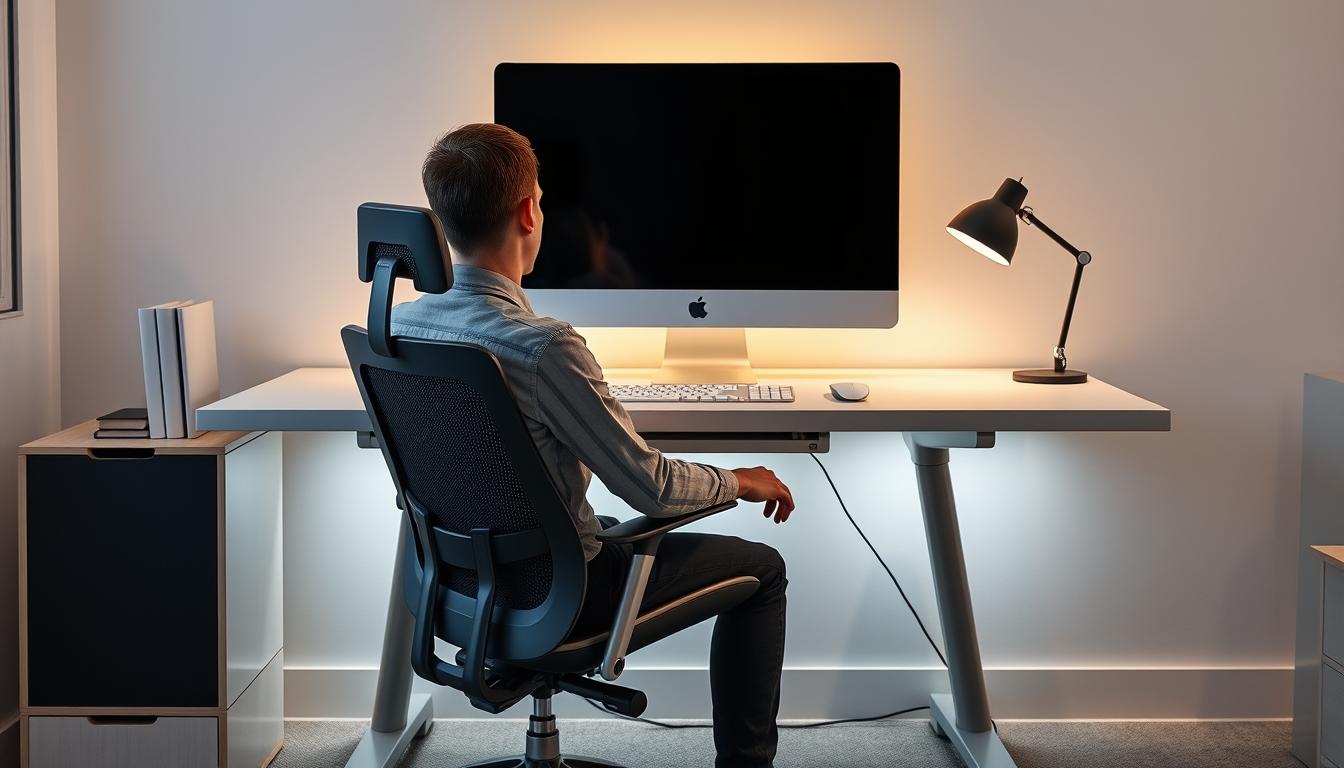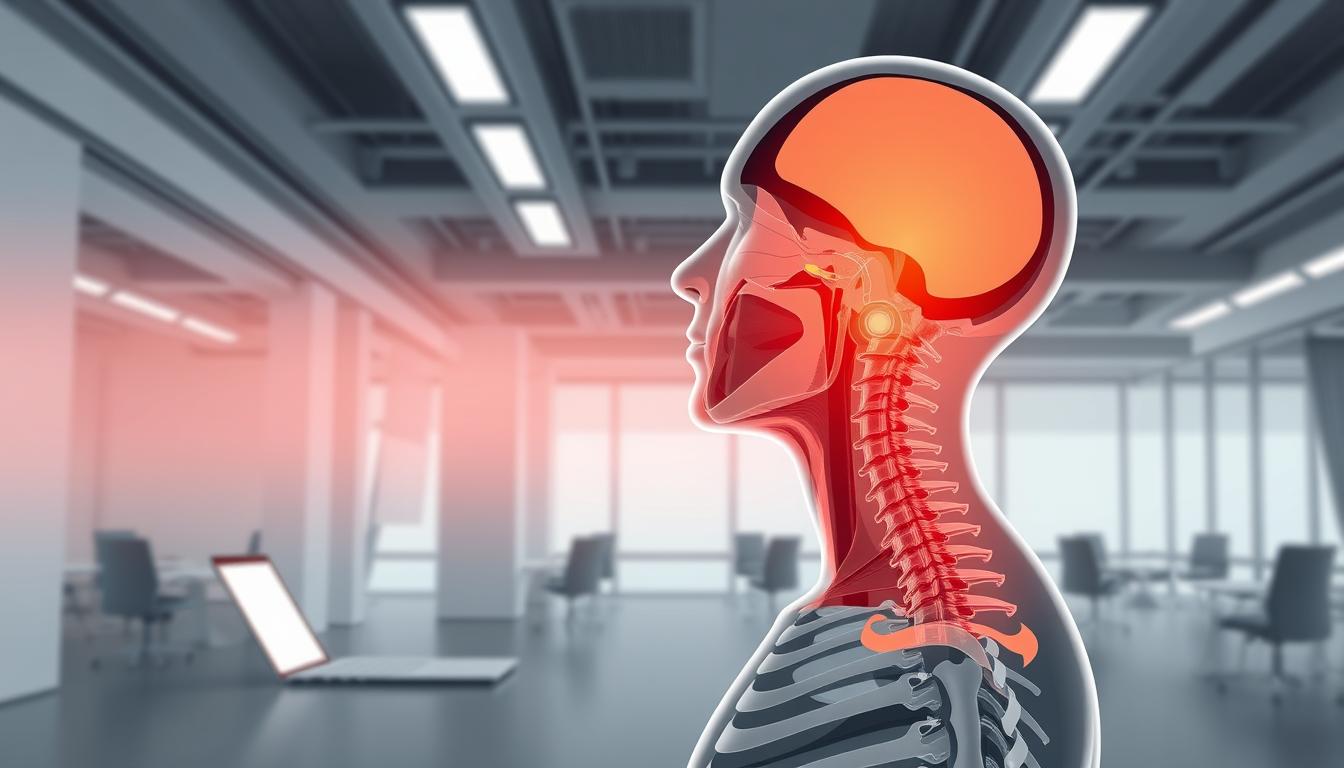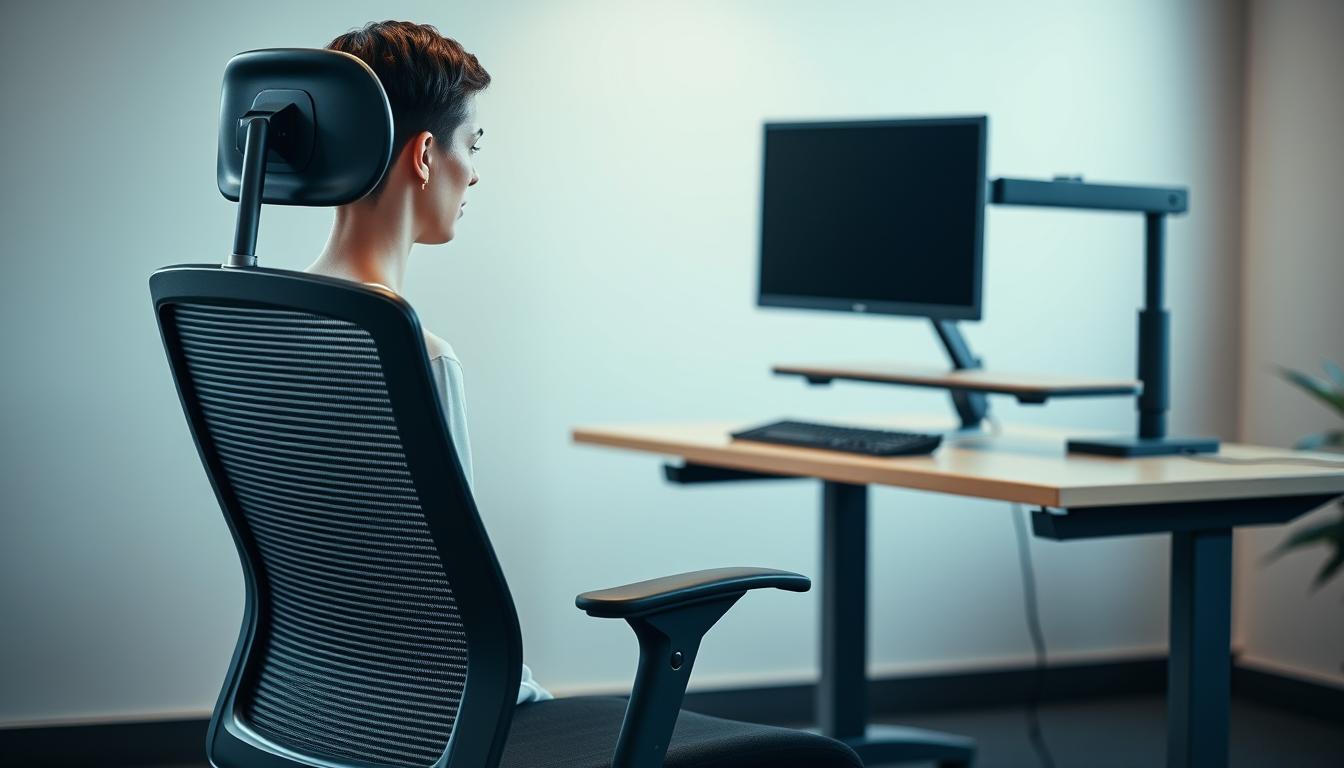In our fast-moving work world, a comfy workstation is key for desk sitters. A setup that’s kind to your neck ups comfort and work speed. Good desk design keeps pain away, making work fun and smooth. We’ll dive into the best ways to arrange your workspace. This ensures comfort and high efficiency.
Understanding Desk Ergonomics and Its Importance
Desk ergonomics is super important for a comfy and effective workspace. Having your desk set up right boosts your work experience. On the flip side, bad ergonomics can lead to health problems that mess with your performance and happiness.
Impact of Poor Ergonomics on Health
Many people don’t realize how bad ergonomics can harm their health. If you don’t set up your desk right, you might face:
- Chronic back pain
- Neck strain
- Carpal tunnel syndrome
- Muscle fatigue
- Headaches
These issues can turn into long-term problems, messing with your daily life and happiness. Knowing the bad effects of not fixing your desk setup is a wake-up call to organize your space carefully.
Benefits of a Well-Designed Workstation
A good desk setup does more than just prevent health problems. It offers big ergonomic perks, like:
- Enhanced comfort throughout the workday
- Promotion of proper posture
- Increased focus and concentration
- Boosted productivity levels
Research shows that focusing on desk ergonomics really helps your well-being. A well-set-up workspace lets you work better without feeling uncomfortable or distracted. Taking the time to make your workspace ergonomic is worth it for your health and work success.
Basic Principles of Ergonomics
Ergonomics aims to make workspaces better for comfort and work. It’s crucial to keep a natural posture. Keeping your spine in its normal shape helps reduce injury and keeps your back healthy.
Everyone needs different ergonomic settings because we’re all different. What helps one person may not help another. Adjusting chairs, desks, and tools to fit each person is key. This helps people be comfortable and work well.
Chair Selection for Ergonomic Comfort
Choosing the right chair is key for a comfy, ergonomic workspace. It boosts comfort and supports good posture. You should know the important features of ergonomic chairs to give your body the support it needs. Look for chairs that let you adjust things to fit you just right.
Features of an Ergonomic Chair
Think about these features when picking an ergonomic chair:
- Comfortable Padding: A soft seat and backrest mean you can sit for a long time without discomfort.
- Adjustable Armrests: They let you change the fit, easing shoulder stress.
- Breathable Material: Mesh or breathable fabrics keep you comfy when sitting for long periods.
Chair Height and Lumar Support
Being able to adjust your chair’s height is crucial. Your feet should be flat on the floor with your knees at a 90-degree angle. This helps with blood flow and reduces tiredness.
Lumbar support is just as important. A chair with good lumbar support keeps your spine’s natural curve. It stops you from slouching and reduces lower back pain.
Desk Height and Arrangement
Getting your desk height right is key for comfort and doing well at work. A perfect desk height lets your elbows bend at 90 degrees when typing, avoiding any strain. Since everyone is different, finding the right setup is crucial for better work performance and health.
Optimal Desk Height Guidelines
When setting up your desk, you need to think about a few things:
- Your chair and leg length must fit well with the desk height.
- Keep your elbows level with the desk to stay comfortable.
- Make sure your feet are flat on the ground or use a footrest.
You should change how your workstation is set up often. The best desk height changes depending on what job you’re doing.
Configurations for Different Tasks
Desk setups can vary based on the work you’re doing. For example:
- When typing, a lower desk helps keep your wrists relaxed.
- If you’re reading documents next to your monitor, you might need a higher desk.
- Using things like keyboard trays can make switching between tasks easy and comfy.
Monitor Positioning for Neck Health
Having your monitor set up right is key to keeping your neck happy. Putting the top of the screen at or a bit below eye level helps a lot. It keeps your head straight and avoids any stress from bending or twisting your neck.
It’s also smart to make sure your monitor isn’t too close or too far away. Keeping it about an arm’s length away is best. This distance cuts down on eye strain and helps you sit better.
Eye Level Alignment Techniques
Here are some tips to get your screen at the perfect height:
- Utilize adjustable monitor stands to customize height.
- Ensure your chair height allows your feet to rest flat on the ground.
- Use external monitors if necessary to maintain proper eye level.
Distance and Angle Expectations
Setting your monitor at the right distance and angle is crucial. Make sure it faces you straight on to avoid turning your head too much. The top of the screen should be tilted back slightly. This helps cut down on glare and makes it easier to see. These tips will make your monitor setup better for your neck and more comfortable for work.
Keyboard and Mouse Placement
It’s important to have your keyboard and mouse set up right. This keeps you comfortable and helps you work better. Having everything placed well can help avoid pain and injury from strain. It’s really key to keep your wrists in a good spot when you’re typing and using the mouse to stay comfy over time.
Maintaining Neutral Wrist Position
For better wrist posture, keep your keyboard near your desk’s edge. This helps keep your wrists straight, so they don’t bend too much. A wrist rest can also support, keeping your wrists in a neutral spot while you type.
Avoiding Extended Reach
Reaching too far can hurt your shoulders and wrists. Make sure your mouse is close enough to grab easily. Keeping these devices level with each other makes everything align better and reduces strain. Think about getting ergonomic tools for your desk to help with this.
Lighting Considerations
Having the right amount of light is key to a comfy and work-friendly space. Good lighting helps lessen eye strain, a usual problem for screen users. By setting up your lights well, you can work better and keep your eyes healthy.
Reducing Eye Strain Through Proper Lighting
Adjustable lights can fight eye strain. You can point them where needed, avoiding too much light. It’s good to use daylight, but add artificial lights to keep the brightness steady. Warm lights help keep you focused and feeling good.
How to Minimize Glare
To avoid discomfort, it’s important to reduce glare. Keep computer screens away from direct light to stop reflections. Using screens that block glare helps too. Mix ceiling lights and lamps for even light that doesn’t hurt your eyes.
Advanced Ergonomic Tools and Accessories
Adding ergonomic tools to your work area can really boost your comfort and how much you get done. Things like standing desks let you switch between standing and sitting. This can stop the problems that come from sitting too much. Studies show that making this switch can lead to better posture and more energy.
Benefits of Standing Desks and Sit-Stand Converters
Standing desks are a great way to fight sitting down too much. Their benefits include helping you move more during the day. They can also give you more energy and help you focus. Plus, they might help you manage your weight and ease back pain.
- Encourages active movement throughout the day
- Boosts energy levels and enhances focus
- Can contribute to weight management and reduced back pain
Sit-stand converters are great because they let you easily change from sitting to standing. This makes your work area better for your health. It keeps your body more active.
Use of Footrests and Document Holders
Footrests make your work setup better by helping your legs’ blood flow, especially if you sit a lot. Putting your feet up can ease discomfort and help your lower body’s alignment.
Document holders keep your papers organized and easy to get to, saving your neck from strain. By keeping documents at eye level, they follow ergonomic principles. This makes working more comfortable.

The Power of Movement in Your Workspace
Making room for movement in your day is key for staying healthy while you work. Staying in one pose too long can tire you out and make you sore. So, it’s important to mix in movement breaks. Taking short moments to move helps keep you energetic and focused.
Incorporating Breaks and Stretching
Planning short breaks for moving around helps ease body stress. Here are some easy tips:
- Set a timer to remind yourself to take a break every 30 to 60 minutes.
- Engage in stretching exercises to ease tightness and become more flexible.
- Walk around your area a bit to get your blood moving and clear your head.
Stretching helps you chill out, which makes you more productive all day.
Dynamic Sitting Solutions
Changing how you sit can fight the downsides of sitting too long. Using things like balance balls, active stools, or desks that let you stand or sit can change how you feel:
- Balance balls make you move a little all the time and work your middle.
- Active stools make you change how you’re sitting, which is good for your back.
- Sit-stand desks let you switch between standing and sitting, helping you feel less tired.
Focusing on moving even while seated is not just comfy but also good for your health in the long run. Try these ideas in your work area for a more lively and healthy workday.
Common Ergonomic Mistakes to Avoid
Many workplace injuries come from ergonomic mistakes. Recognizing and fixing posture problems can greatly improve comfort and productivity. Making small changes at your workstation can lead to major health benefits.
Properly applying ergonomic principles can prevent discomfort. It can also ease strain throughout your workday.
Identifying and Correcting Posture Issues
In many offices, the way monitors and chairs are set up is a big mistake. Having monitors too low or too high can cause a strained neck and bad posture. Checking your workspace regularly is key to fixing posture issues.
Also, a chair that supports your spine’s natural curve can lead to a healthier work position.
- Check if your monitor is at eye level.
- Adjust your chair height so your feet rest flat on the ground.
- Keep your wrists neutral while typing.
The Importance of Avoiding Static Positions
It’s important to avoid staying in one position for too long at work. Staying still too long can lead to muscle stiffness and tiredness. Moving around, like standing, stretching, or walking, can help reduce stress on your body.
Taking regular breaks can also help keep your blood flowing and keep you comfortable.
Neck-Friendly Workstation Checklist
It’s key to have an ergonomic workstation to keep your neck healthy and comfy. By using a detailed checklist, you can make sure every part of your desk area helps you stay in good shape. This list includes important points for checking your space and tips to make it better.
Key Items to Assess in Your Setup
- Chair height: Adjust your chair so that your feet rest flat on the floor, allowing your knees to be at a 90-degree angle.
- Monitor positioning: Ensure that your monitor is at eye level, approximately an arm’s length away to reduce strain on your neck.
- Keyboard placement: Keep the keyboard at a height that allows your elbows to remain close to your body and at a 90-degree angle.
- Mouse location: Place the mouse at the same level as the keyboard, minimizing the need for extended reaching.
- Lighting conditions: Optimize soft lighting to reduce glare and prevent eye strain, supporting better focus and comfort.
Final Tips for Optimization
Doing ergonomic checks often is very helpful for your work area. Include tips, like taking quick breaks to stretch and change your position. Adjust your equipment when needed. Think about getting things like wrist supports or adjustable stands for more comfort. Using a full workstation checklist can make your work area healthier. This leads to more productivity and feeling better overall.
Conclusion
A good ergonomic setup is key for getting work done and staying healthy. Making your workspace neck-friendly boosts comfort and lowers health risks. Taking care of your whole workspace improves your overall well-being.
It’s important to regularly check your ergonomic setup, as your needs might change. Changing your workspace to fit your needs helps keep your body healthy. By following ergonomic principles, you can make a workspace that’s both efficient and good for your health.
Putting money into an ergonomic workstation means investing in your own health. Getting the right setup now helps you stay healthy and work better in the future. Make these changes in your space to keep comfortable and healthy for a long time.



